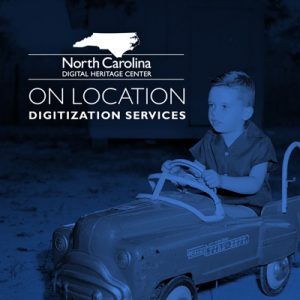Thanks to our partner, Caswell County Public Library, we now have several issues of yearbooks from Caswell County on our website. The yearbooks are from Bartlett Yancey High School in Yanceyville, N.C. and Cobb Memorial High School in Ruffin, N.C. and cover the years 1947-1969.
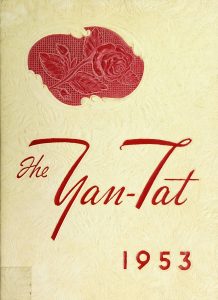
Cover of the 1953 yearbook for Bartlett Yancey High School in Yanceyville, N.C.
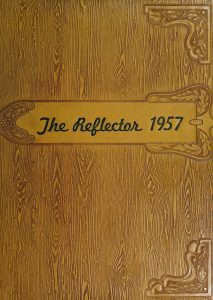
Cover of the 1957 yearbook for Cobb Memorial High School in Ruffin, N.C.
To view more North Carolina Yearbooks, visit our exhibit page here and for more about Caswell County Public Library, visit their website.
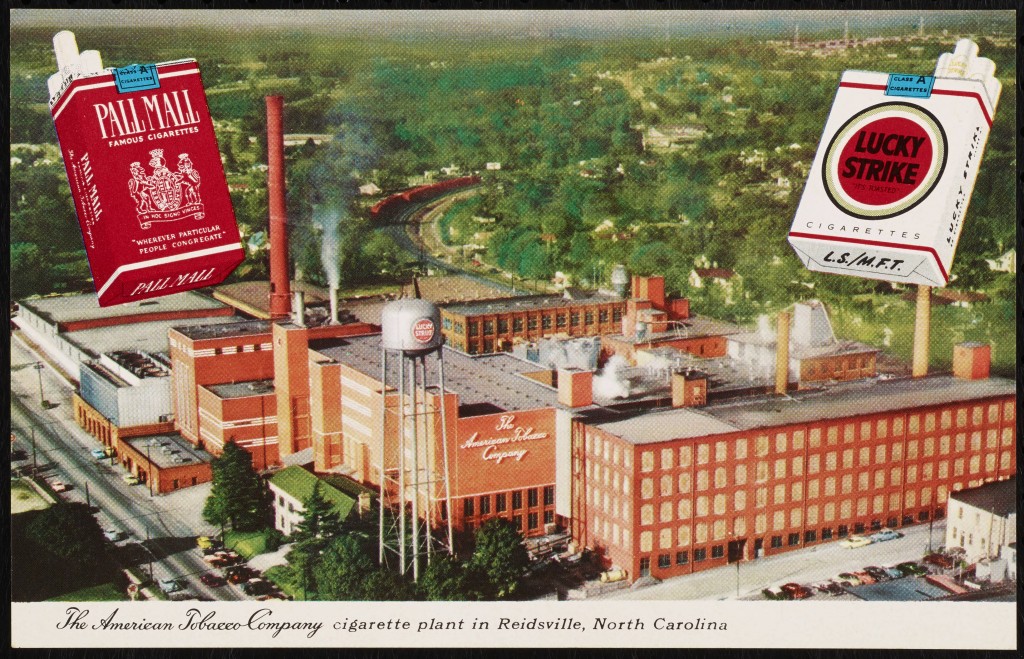
Postcard showing The American Tobacco Company cigarette plant in Reidsville, North Carolina.
We’ve recently finished digitizing and publishing online more local history materials from Rockingham County Public Library. This is another batch coordinated as part of a 2014-2015 Library Services and Technology Act (LSTA) EZ Digitzation Grant, and we’re excited to share these with you.
Periodicals added with this batch include Insights to Jerusalem, a newsletter published by the Jerusalem United Holy Church of America in Reidsville, NC. These volumes, from 1990-1994, include church news, recipes, short essays, and more. Old Rockingham County Magazine, also published during the 1990s, is a variety magazine with stories, historical anecdotes, household hints, ads, and local lore.
There are also a number of additional volumes of research on a variety of Rockingham County residents and topics by local historian John T. Dallas.
The remaining items include materials about the American Tobacco Company (The Story of Lucky Strike, and a postcard of the plant in Reidsville), two reports on civil rights in Reidsville, and a scrapbook full of newspaper clippings and ephemera documenting Washington Mills.
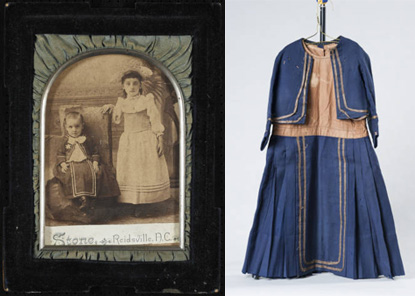
A photograph of James Bracken Watlington and his sister, Mary Jane Watlington has been digitized and is now available online along with several other artifacts from the collection of the Museum & Archives of Rockingham County. The photograph of the Watlington children is a particularly interesting because the dress worn by James has also been digitized and is likewise hosted on DigitalNC.org. The photograph provides context for the garment, and the garment adds to the level of detail visible in the photograph, which is decidedly a win-win for all. The digitized garment shows the rich blue and gold colors and embroidery in the dress as well as many details that were not captured in the 1895 photograph of James and Mary Jane. James’ dress, which is contemporary with the portrait of the children, is approximately 125 years old and in impressive shape considering its age.
Mary Jane and James Bracken Watlington, were born in the 1880s to a prominent Caswell County family. The photograph of the siblings showcases the differences between boys’ and girls’ dresses; James’ dress is navy blue with masculine, nearly nautical details, and features a bow tie. Mary Jane’s costume, by contrast, is lacy with ruffles at the shoulders and sleeves, of a light color, and completed with a girlish hat. Historically, boy’s dresses were worn by toddlers and young boys for convenience’s sake; they were more practical than breeches, which often involved complicated latching mechanisms too difficult for little hands to maneuver. Dresses were practical for young children of all ages as it was easier to extend the hem as the child grew to increase the longevity of the garment – an important quality when garments were so much more expensive than they are today. James’ dress, like all boys’ dresses in general, has masculine features that differentiate it from girls’ dresses, such as the color or cut of the neckline and sleeves. Boys were presented their first pair of pants in a breeching ceremony, typically between the ages of around 4 and 7.
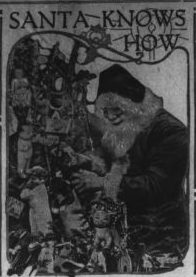
Thanks to our partner, University of North Carolina at Chapel Hill, new issues from five North Carolina newspapers are available on our website. These include:
There are also new issues of Oxford Public Ledger, courtesy of our partner Granville County Public Library, and The Yadkin Ripple, thanks to Yadkin County Public Library.
To browse all of our newspapers by location, date, and type, take a look at our North Carolina Newspapers collection.
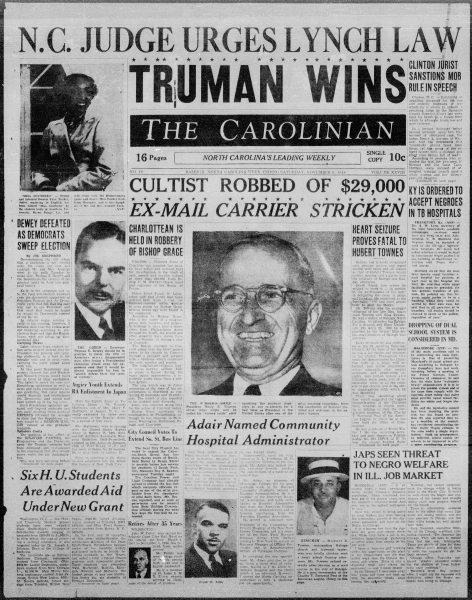
An issue of The Carolinian (Raleigh) newspaper from November 6, 1948.
It’s time to announce our annual round of microfilmed newspaper digitization! As in previous years, we’re asking cultural heritage institutions in North Carolina to nominate papers from their communities to be digitized. We’re especially interested in:
- newspapers covering underrepresented regions or communities, and
- newspapers that are not currently available in digital form elsewhere online.
If your institution is in one of these counties, please consider nominating! These are counties that currently have little content represented on DigitalNC. Bertie, Bladen, Camden, Caswell, Clay, Gates, Hoke, Jones, Northampton, Onslow, Pamlico, Swain, Tyrrell.
If you’re interested in nominating a paper and you work at a cultural heritage institution that qualifies as a partner, here’s what to do:
- Check out our criteria for selecting newspapers, listed below.
- Verify that the newspaper you’d like to see digitized exists on microfilm. Email us (digitalnc@unc.edu) if you’re not sure.
- Be prepared to talk with the rights holder(s) to gain written permission to digitize the paper and share it online. We can give you advice on this part, if needed.
- Send us an email with the name of the newspaper you would like to nominate, along with your priority years for scanning. Please talk briefly about how the paper and your institution meet the criteria below.
Nominations will be taken on an ongoing basis, however don’t wait! We typically get many more requests than we can accommodate. Please contact us at digitalnc@unc.edu with questions. We’re looking forward to hearing from you.
Criteria for Selecting Newspapers to Digitize from Microfilm
Titles to be digitized will be selected using the following criteria:
- Does the newspaper document traditionally underrepresented regions or communities?
- Does the newspaper include significant coverage of the local community or largely syndicated content?
- Does the newspaper come from an area of the state that has little representation on DigitalNC? (Titles that have not previously been digitized will be given priority. Here’s a title list and a map showing coverage.)
- Are the images on microfilm legible, or is it difficult to read the text?
- Is the institution willing to obtain permission from the current publisher or rights holder(s) to digitize issues and make them freely available online?
- If the newspaper is selected for digitization, will the nominating institution promote the digital project through programs and announcements?
*Updated 8/9/2019 to add county list.
Have you been interested in working with the Digital Heritage Center but find it difficult to get to Chapel Hill, or have concerns about having your materials off site? We want to come to you! We’ll be working with two or three cultural heritage institutions over the next nine months to try out on-location scanning. If you’d like to nominate your institution, read on and use the nomination form linked at the end of this post.
What We Do
Here’s what nominated institutions will receive as part of this process.
- We will bring our scanners, computers, and staff to your institution to digitize and describe materials from your collections. We would be there for one full weekday, at a minimum.
- We’ll host the scanned images and associated metadata on DigitalNC.org, and give you copies of the original scans to use in any non-profit context.
- Optionally, we can do a presentation for staff and/or the public related to any of the following topics:
- The Digital Heritage Center’s services (for staff at your institution and/or other local cultural heritage institutions)
- A demonstration of what we’re doing while we’re there (for staff at your institution)
- The variety of resources you can find on DigitalNC.org and other fantastic digital collections in North Carolina (staff or the public)
What We’ll Need from Partners We Visit
If you’re chosen, we’d need:
- At least one conference call before arrival to clarify expectations, work with you on scheduling, and talk through the materials you’d like scanned.
- Description and a light inventory of the items we’ll be scanning, if there isn’t one already available.
- Some assembly and preparation of the materials you’ve chosen. This might include physically pulling all of the content together before we arrive and removing staples if the materials are stapled at the top corners.
- A designated staff contact regularly available to ask questions regarding what we’re scanning while we’re there, and to help with logistics like getting equipment in and out of the building, etc.
- An indoor location that has:
- at least two power outlets,
- internet connectivity,
- a work area large enough for 2 scanners and 4 laptops as well as extra room for materials handling,
- seating for four people, and
- is away from the public so we can get the most scanning accomplished in our limited time (ideal but not required).
Additional Guidance for Nominations
- We’ll be giving priority to nominations from institutions furthest from Chapel Hill and to new partners. If you are a prospective partner, please check to make sure you’re eligible.
- The materials have to be owned by your institution.
- The materials should cover North Carolina subjects, events, and people.
- For these on-location sessions, we’re accepting nominations for the following types of items:
- photographs (prints) and/or postcards
- looseleaf print materials up to 11×17”
- bound items may be considered, but in very limited numbers and only if transporting them to Chapel Hill would be impossible
- Materials can be fragile but should be stable enough to withstand gentle handling and placement on a flatbed scanner.
We’ll review nominations according to the following criteria, so you may want to address these in your nomination form:
| Category |
Point Value |
| New partner |
1 |
| New town |
1 |
| New county** |
2 |
Materials document an underrepresented
community or population |
1 |
| Materials are well described/inventoried |
5 |
| Majority of materials date from 1945 or earlier |
1 |
| Materials are believed to be unique |
1 |
** We have yet to work with any institutions in the following counties: Alexander, Bertie, Bladen, Camden, Caswell, Chowan, Clay, Currituck, Dare, Gates, Graham, Greene, Henderson, Hoke, Jones, Mitchell, Northampton, Onslow, Pamlico, Swain, Tyrrell, Yancey
Use this nomination form to submit!
We’ll start reviewing nominations on September 30 and will notify selected institutions shortly thereafter. If a selected institution ends up not being able to host us, we’ll continue down the list.
We’re excited about trying out this new service. Please contact us with any questions and share this with any institutions you think might be interested.






